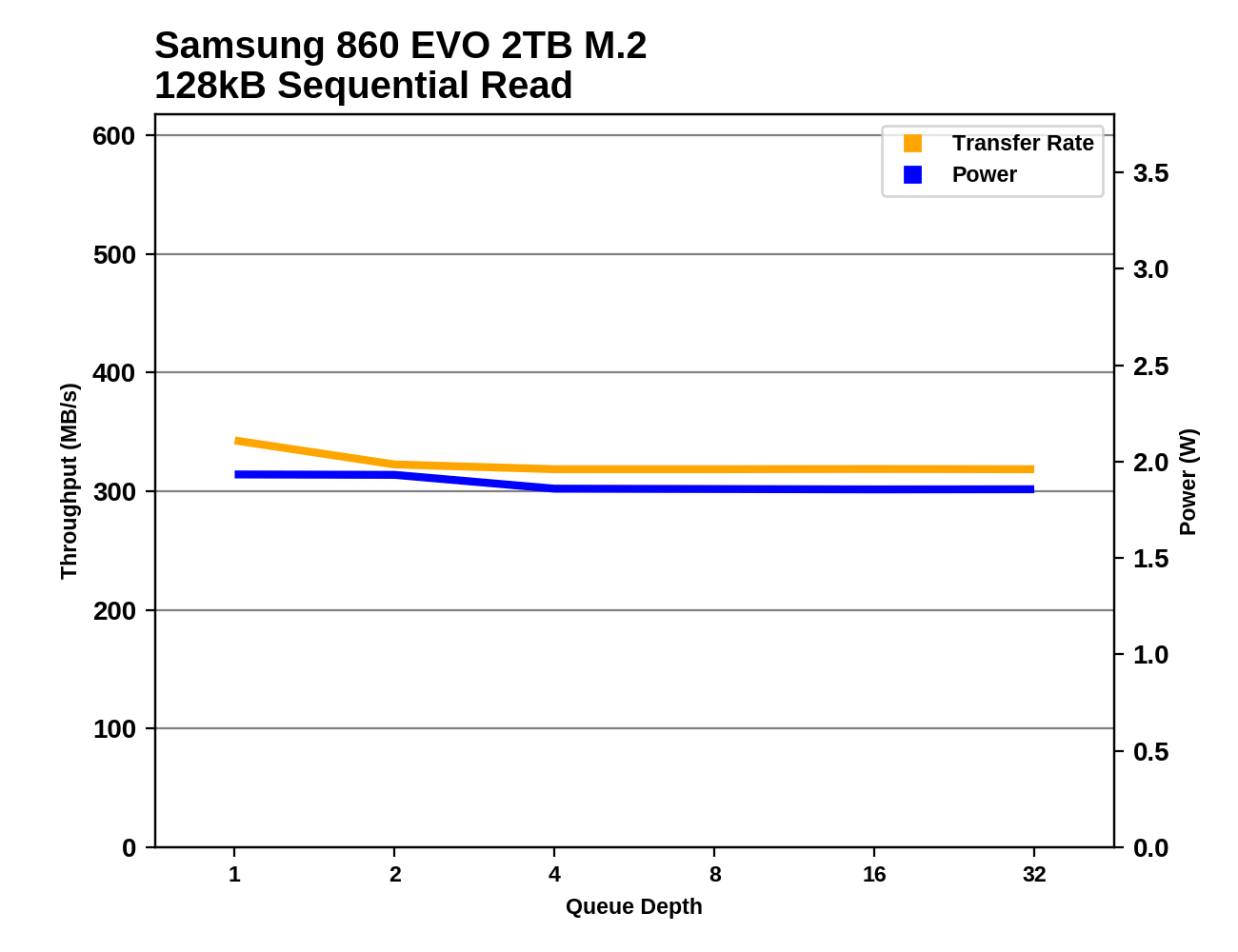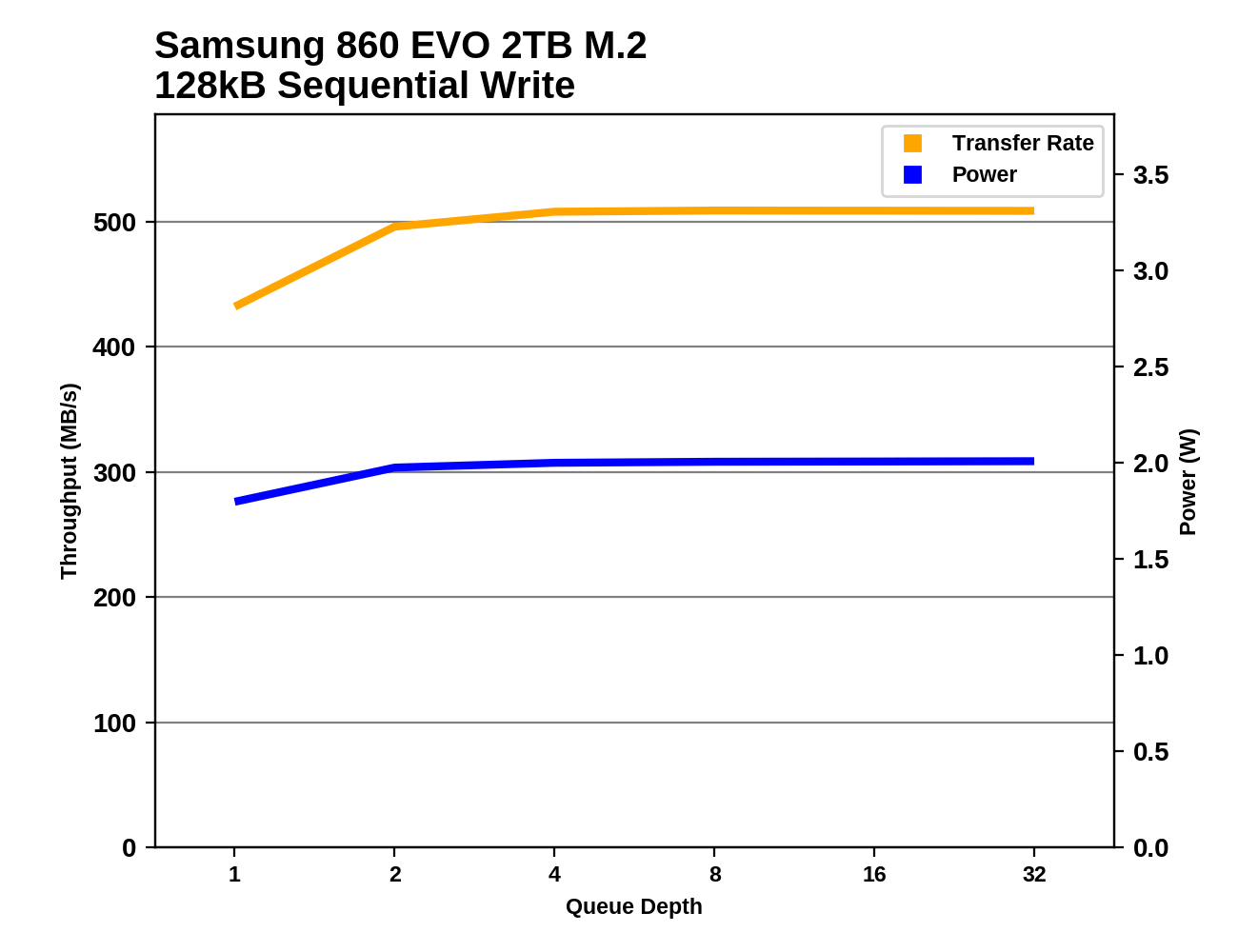The Latest High-Capacity M.2: The Samsung 860 EVO 2TB SSD, Reviewed
by Billy Tallis on February 14, 2018 1:40 PM ESTSequential Read Performance
Our first test of sequential read performance uses short bursts of 128MB, issued as 128kB operations with no queuing. The test averages performance across eight bursts for a total of 1GB of data transferred from a drive containing 16GB of data. Between each burst the drive is given enough idle time to keep the overall duty cycle at 20%.

The burst sequential read performance of the 850 EVO was no longer up to par, but the 860 EVO fixes that and puts Samsung back on top among TLC drives.
Our test of sustained sequential reads uses queue depths from 1 to 32, with the performance and power scores computed as the average of QD1, QD2 and QD4. Each queue depth is tested for up to one minute or 32GB transferred, from a drive containing 64GB of data.

The sustained sequential read performance of the 860 EVO takes a surprising step backward, falling behind the Crucial and SanDisk drives. This test runs on a data set that has been fragmented by some random writes, and the performance regression is may be due to an increase in NAND page sizes with Samsung's 512Gb 64L TLC, making more work for the drive to unravel its internal fragmentation.

In spite of the performance regression, the 860 EVO still manages to slightly improve power efficiency on the sequential read test, bringing it close to the SanDisk Ultra 3D.
 |
|||||||||
The Samsung 860 EVO shows very little dependence on queue depth for either performance or power consumption. Its power consumption is just under 2W at this speed, while the 860 PRO draws just over 2W when saturating the SATA link.
Sequential Write Performance
Our test of sequential write burst performance is structured identically to the sequential read burst performance test save for the direction of the data transfer. Each burst writes 128MB as 128kB operations issued at QD1, for a total of 1GB of data written to a drive containing 16GB of data.

The burst sequential write speed of the 860 EVO is the same as the 850 EVO and 850 PRO. The Crucial MX300 and 4TB 860 PRO are slightly faster, but overall there isn't much variation on this test.
Our test of sustained sequential writes is structured identically to our sustained sequential read test, save for the direction of the data transfers. Queue depths range from 1 to 32 and each queue depth is tested for up to one minute or 32GB, followed by up to one minute of idle time for the drive to cool off and perform garbage collection. The test is confined to a 64GB span of the drive.

The 860 EVO saturates the SATA bus on the longer sequential write test that hits higher queue depths. Performance is a few MB/s faster than the 850 EVO, but that is an insignificant difference.

Almost all of these SSDs offer near identical performance on this test, but their power efficiency varies greatly. The 860 EVO is almost on par with the 860 PRO, and both are far more efficient than their predecessors and their current competition.
 |
|||||||||
As with random writes, the sequential write performance of most of these drives saturates around QD4. The Samsung 860 EVO draws almost exactly 2W, lower than anything else except the 860 PRO.










32 Comments
View All Comments
DanNeely - Wednesday, February 14, 2018 - link
Did you do the performance tests via the sata-m2 adapter too? If so will you be re-running them in PCIe mode next?JanW1 - Wednesday, February 14, 2018 - link
This is a M.2 SATA drive, no point in trying to run tests in PCIe mode.Flunk - Thursday, February 15, 2018 - link
I can already tell you the results, they're all 0.Drazick - Wednesday, February 14, 2018 - link
M.2 is perfect for Laptop's.Why don't we see U.2 for Desktop's?
It will mitigate most throttling issues.
Not to say simplify the Mother Boards.
CheapSushi - Thursday, February 15, 2018 - link
There are U.2 for desktops....But U.2 is NVMe/PCIe based. This is SATA/AHCI. You can turn a mini-SAS port and I think U.2 (correct me if wrong) into a quad SATA port with appropriate cable. Nothing wrong with SATA/AHCI for a bulk storage drive. Unless you'e assuming everyone just wants ONE drive for the entire system.BurntMyBacon - Thursday, February 15, 2018 - link
In a system you would want to use the U.2 port in, there is a decent probability that a second drive will be desired if not already present. Like you said, "Nothing wrong with SATA/AHCI for a bulk storage drive". For systems that you can rule out a bulk storage drive, there is a high probability that nVME needs will be served by M.2 rather than U.2.Though some can tell a difference, it is not even certain that most perceive the performance benefit moving from a fast SATA SSD to an nVME SSD for a primary disk due to how current operating systems handle the storage subsystem.
Bulat Ziganshin - Thursday, February 15, 2018 - link
3dnews.ru testing shown that 512 GB model sometimes is slower than 850EVO, due to lower parallelism. It's why Samsung sent you 2TB model for tests insteadyankeeDDL - Thursday, February 15, 2018 - link
Why was the 960 EVO/PRO not included?SpaceRanger - Thursday, February 15, 2018 - link
Because this is a SATA drive, not an NVME drive.Flunk - Thursday, February 15, 2018 - link
As such they utterly destroy this.